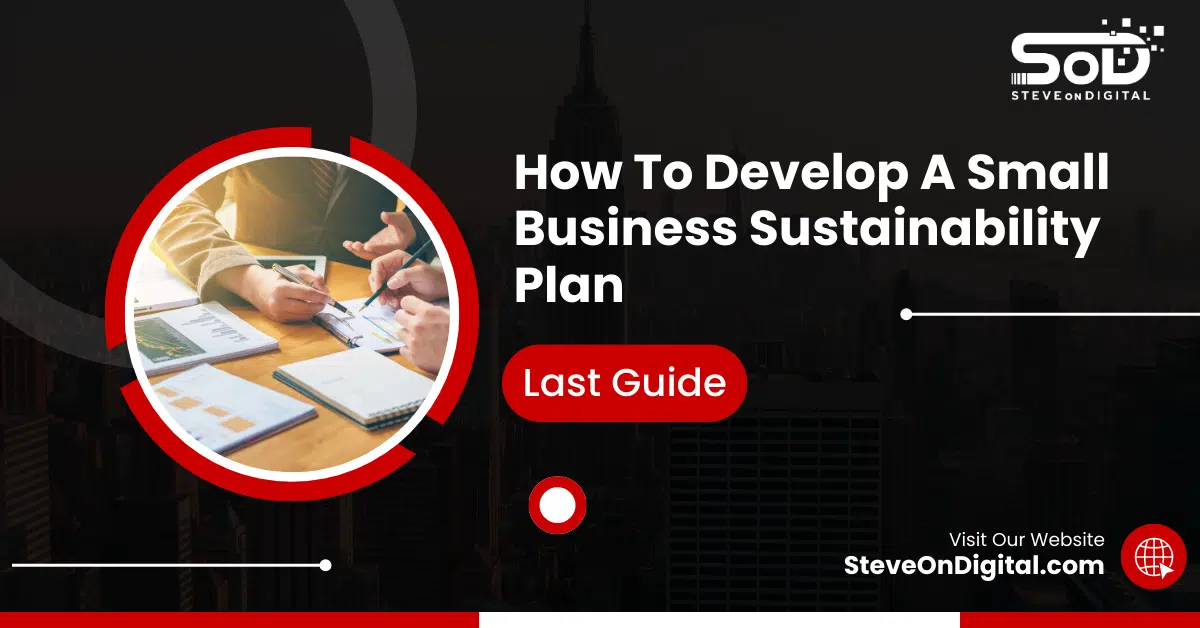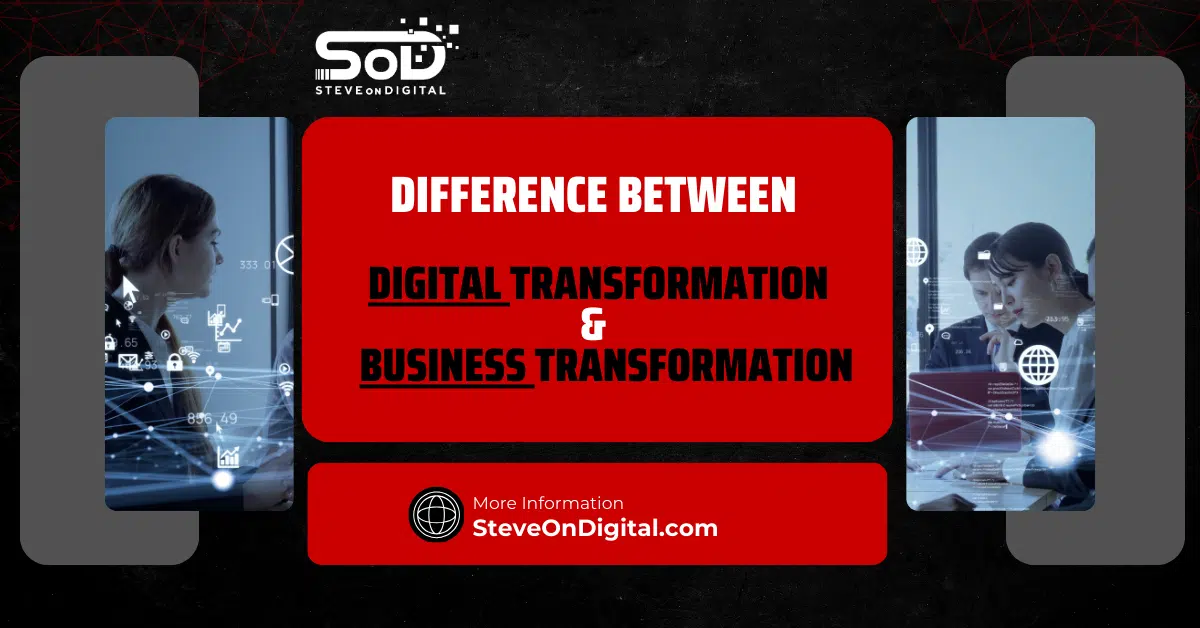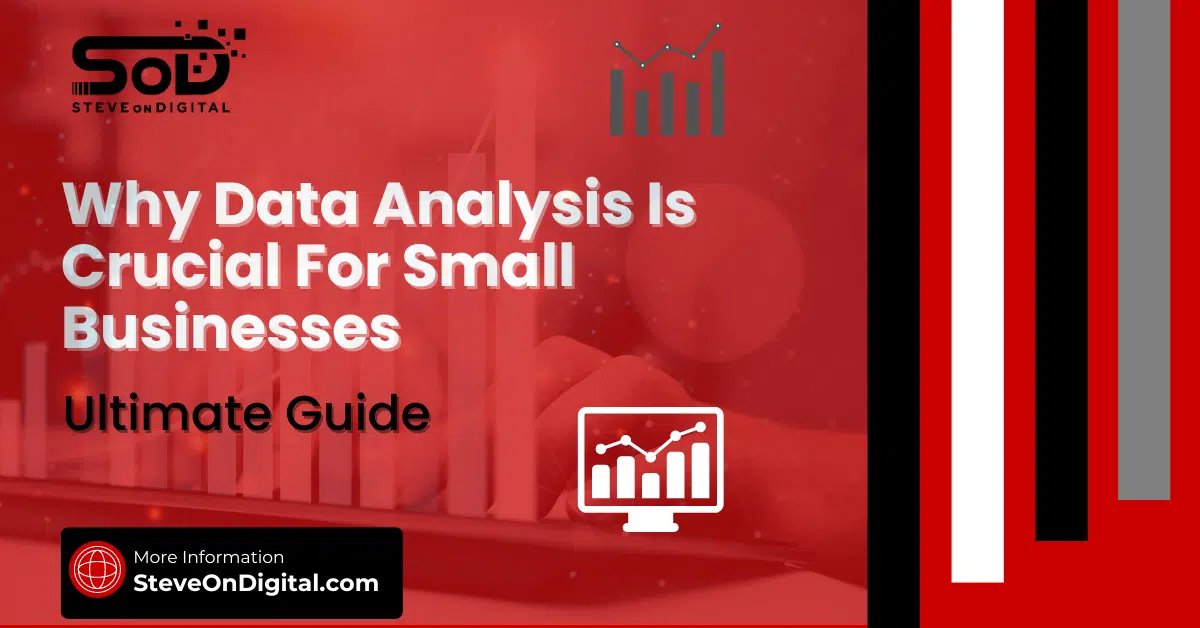As a small business owner and the mind behind SteveOnDigital, I recognize the urgency and necessity of integrating sustainability into our business practices. In today’s rapidly changing environment, developing a sustainability plan is not just about being responsible; it’s about ensuring the future of our business and the world we live in.
Why Embrace Sustainability? The Compelling Case For Small Businesses
Embracing environmental sustainability within your small business isn’t just beneficial for the planet—it’s a strategic business move. Research shows that sustainability is increasingly influencing consumer choices. A significant 50% of consumers now consider sustainability one of their top four purchasing criteria (TravelPerk). Moreover, businesses that invest in sustainable practices report financial benefits too. A McKinsey study found that companies incorporating environmental, social, and governance (ESG) factors into their growth strategies were twice as likely to see a revenue increase of 10% or more (TravelPerk).
Economic Benefits Of Sustainability
Sustainability can lead to substantial cost savings, primarily through improved energy efficiency and reduced waste. Businesses worldwide could save a significant amount annually by 2030 through energy efficiency alone (TravelPerk). On my journey with SteveOnDigital, I’ve seen firsthand how small changes, like upgrading to LED lighting or optimizing our digital tools, not only reduce costs but also enhance operational efficiency.
Boosting Customer Loyalty And Brand Image
Today’s consumers are more eco-conscious than ever. They’re willing to pay more for products from sustainable companies, and they value transparency about sustainable practices. By aligning your business with these values, you not only attract a loyal customer base but also enhance your brand’s reputation (TravelPerk) (QuickBooks).
Competitive Advantage
Adopting sustainable practices can distinguish your small business from competitors. As we integrate eco-friendly solutions at SteveOnDigital, I’ve noticed how it piques the interest of potential clients and partners who are eager to support green businesses. This not only opens new markets but also strengthens our standing in the industry.
Integrating sustainability isn’t just about adopting new practices—it’s about setting a foundation for future growth and stability. Whether it’s through reducing energy consumption, optimizing supply chains, or ensuring that all business activities are geared towards minimizing environmental impact, the goal is clear: a sustainable business is a thriving business. By focusing on these key areas, we position our small businesses not just to survive but to thrive in a future where sustainability is expected, not just appreciated.
Building The Foundation: Key Components Of A Small Business Sustainability Plan
Over the years, I’ve learned that laying a strong foundation is crucial for any successful initiative—especially when it comes to sustainability in small businesses. A well-thought-out sustainability plan not only addresses immediate environmental concerns but also sets up a business for long-term success. It’s important to create a sustainable business plan that incorporates creativity, innovation, and self-reflection to identify new ways to reduce waste and energy consumption.
Defining Your Sustainability Vision
Every impactful journey begins with a clear vision. For small businesses aiming to integrate sustainability, this vision should encapsulate not just what you aim to achieve but also why it matters. This vision might be about reducing energy consumption, minimizing waste, or enhancing your community’s well-being—goals that reflect both your values and business objectives. For instance, at SteveOnDigital, our vision for sustainability involves reducing our carbon footprint while enhancing digital efficiency for our clients.
Conducting A Thorough Sustainability Assessment
To know where you’re going, you must first understand where you stand. A sustainability assessment involves a detailed evaluation of your current practices and their environmental impact. This might include examining your energy usage, waste management practices, and supply chain operations. Tools like carbon calculators and energy audits can be invaluable here, providing insights into areas where your business can improve. Data shows that many businesses are now adopting more sustainable practices, with significant emphasis on energy efficiency (TravelPerk).
Setting Achievable Sustainability Goals
Once you’ve assessed your current state, the next step is to set concrete, achievable sustainability goals. These should be SMART: Specific, Measurable, Achievable, Relevant, and Time-bound. For example, you might aim to reduce your office’s energy consumption by 20% within the next two years or achieve zero waste to landfill by 2025. These goals not only guide your sustainability efforts but also help motivate your team by providing clear targets to strive for.
Implementing Effective Sustainability Initiatives
With your sustainability goals set, it’s crucial for small businesses to start implementing sustainable business practices. This could mean investing in energy-efficient appliances, switching to renewable energy sources like solar panels, improving your recycling processes, or using renewable materials and facilitating virtual meetings to reduce carbon footprint. The key is to choose initiatives that align with both your sustainability goals and business needs. For instance, upgrading to LED lighting not only reduces energy consumption but also cuts down on maintenance costs, offering quick returns on investment (TravelPerk) (QuickBooks).
Overcoming Common Challenges
Adopting new practices isn’t without its challenges. Small businesses often face hurdles such as limited budgets, lack of expertise, or resistance to change.

Overcoming these challenges requires creativity and persistence. Financial incentives, such as grants or tax breaks, can ease budget constraints. Training and engaging employees can help foster a culture that embraces sustainable practices.
Sustainability In Action: Case Studies And Success Stories
To illustrate what’s possible, let’s look at some real-life examples of small businesses that have successfully implemented sustainability plans. These stories not only serve as inspiration but also as proof that small businesses can make a significant impact. For instance, a local café might reduce waste by implementing comprehensive recycling and composting programs, while a small manufacturing firm might decrease its environmental impact by adopting more efficient production techniques.
These elements form the core of a robust small business sustainability plan. By defining a clear vision, conducting thorough assessments, setting specific goals, implementing effective initiatives, and overcoming challenges, your business can not only contribute positively to the environment but also enhance its operational efficiency and brand reputation.
Deep Dive Into Sustainability Practices
I’ve learned that sustainability isn’t just a trend; it’s a vital part of business strategy that can significantly enhance our operations and public image.
Energy Efficiency And Renewable Energy Solutions
Reducing energy use is not only good for the planet but also good for the bottom line. At SteveOnDigital, we’ve taken several steps to enhance energy efficiency, which I believe any small business can replicate:
- Adopting Energy-Efficient Appliances: Upgrading to high-efficiency appliances can reduce energy consumption significantly. For example, energy-efficient servers for digital businesses or upgrading to LED lighting in physical stores can cut down electricity bills.
- Integrating Renewable Energy Sources: Installing solar panels has been one of our most rewarding decisions. It not only reduced our dependence on traditional energy sources but also demonstrated our commitment to sustainable practices. The upfront investment is offset by long-term savings and potential tax incentives, which vary by location but often make the investment worthwhile (TravelPerk).
Waste Reduction And Recycling Efforts
Minimizing waste is crucial for any sustainability plan. Here’s how we address waste reduction:
- Implementing Recycling Programs: We ensure that all recyclable materials, such as paper, plastics, and electronics, are correctly sorted and recycled. This effort not only helps conserve natural resources but also reduces disposal costs.
- Using Recycled Materials: Where possible, we use recycled materials for our office supplies and packaging. This practice has not only reduced our environmental impact but also resonated well with our customers who value environmental stewardship (TravelPerk).
Sustainable Supply Chain Management
A sustainable supply chain is key to reducing your overall environmental footprint. Here’s what we focus on:
- Ethical Sourcing: We prioritize suppliers who demonstrate a commitment to sustainable practices. This includes using sustainable materials and reducing carbon emissions in their operations.
- Reducing Environmental Impacts: We work closely with our suppliers to minimize the environmental impact of their shipping and logistics. This includes optimizing delivery routes to reduce fuel consumption and encouraging the use of electric vehicles (TravelPerk) (QuickBooks).
Promoting Environmental Stewardship
Fostering a culture of sustainability within a business and across its community interactions is essential:
- Employee Engagement: We encourage our team to participate in local environmental initiatives and provide opportunities for them to contribute ideas on how we can improve our sustainability efforts. This engagement boosts morale and fosters a team-oriented approach to tackling environmental challenges.
- Community Involvement: At SteveOnDigital, we engage with our local community by participating in environmental clean-ups and educational programs. This involvement not only helps strengthen our community ties but also amplifies the impact of our sustainability efforts.
Engaging Your Team And Community In Sustainability
Engaging both your team and the local community in your business’s sustainability efforts is crucial. It’s not just about making your operations greener; it’s about building a culture that values sustainable practices at every level. Here’s how we’ve been doing it:
- Employee Engagement: We involve our team in setting our sustainability goals, which boosts their commitment and enthusiasm. We hold regular workshops and training sessions to educate them on why these efforts matter and how they can contribute both at work and at home.
- Community Involvement: We partner with local organizations on environmental projects. For example, we participate in local clean-up days and sponsor events focused on promoting sustainability in the community. This not only helps the environment but also strengthens our connections within the community, enhancing our public image.
These initiatives are vital as they foster a shared responsibility and collective action towards sustainability, making the efforts more impactful and meaningful.
Monitoring, Reporting, And Evolving Your Sustainability Plan
Monitoring and reporting on our sustainability initiatives are key to understanding their impact and improving them over time. At SteveOnDigital, we use a range of key performance indicators (KPIs) to measure our progress:
- Energy Consumption: We track reductions in energy usage month-over-month and year-over-year.
- Waste Reduction: We monitor the amount of waste diverted from landfills through recycling and reuse initiatives.
- Employee Participation: We measure employee involvement in our sustainability programs to gauge engagement and identify areas for improvement.
| KPI | Description | Importance |
| Energy Consumption | Measures the amount of energy used | Helps identify areas for improving energy efficiency |
| Waste Reduction | Tracks the reduction of waste produced by the business | Essential for measuring the effectiveness of recycling programs |
| Employee Participation | Percentage of employees actively involved in sustainability programs | Indicates the engagement level and potential training needs |
We regularly report these findings to all stakeholders, ensuring transparency and accountability. This not only helps us see where we need to adjust our strategies but also communicates to our customers and partners that we are serious about our commitment to sustainability.
Leveraging Technology For Sustainability
Technology plays a critical role in enhancing our sustainability efforts.

We use digital tools to streamline operations and reduce waste.
For example:
- Smart Thermostats: These devices help us optimize our energy use for heating and cooling, reducing consumption without sacrificing comfort.
- Cloud Computing: By moving to cloud services, we reduce the need for physical servers, which lowers our energy use and decreases our carbon footprint.
These technologies not only help us operate more efficiently but also significantly lower our environmental impact.
Navigating Legal And Regulatory Landscapes
Staying compliant with environmental regulations is non-negotiable. We keep abreast of relevant legislation that affects our business, ensuring that our sustainability practices are not only effective but also legally sound. This includes:
- Recycling Laws: We follow state-specific recycling regulations to ensure proper waste handling.
- Emissions Standards: We comply with local and federal emissions standards, which helps us manage our carbon footprint responsibly.
Understanding and adhering to these laws is crucial for any small business looking to implement a sustainability plan. It protects the business from legal risks and underscores our commitment to lawful and ethical business practices.
By taking these steps, we not only improve our sustainability but also enhance our operational efficiencies, reduce costs, and build a positive brand image that resonates well with customers and employees alike.
Securing Funding And Resources For Sustainability Initiatives
Finding the funds to support sustainability initiatives can be challenging, but it’s far from impossible. Several financing options are available to small businesses looking to go green:
- Government Grants and Incentives: Many governments offer grants, rebates, or tax incentives to support sustainable business practices. These can significantly reduce the initial costs associated with projects like installing solar panels or upgrading to energy-efficient equipment.
- Private Funding: Some private organizations provide grants or low-interest loans to businesses committing to sustainability. These are often competitive but can offer substantial financial support.
- Crowdfunding: Leveraging platforms like Kickstarter or GoFundMe to raise funds for specific sustainability projects can also be an effective way to engage your community while securing necessary funds.
| Funding Type | Description | Pros | Cons |
| Government Grants | Financial support from government bodies | Non-repayable, often comes with support resources | Can be competitive, strict eligibility |
| Private Funding | Loans or grants from private entities | Potentially large funding amounts | Might have interest or require equity |
| Crowdfunding | Raising small amounts of money from a large number of people | Engages community, validates business idea | Uncertain funding, requires marketing |
These resources not only help alleviate the financial burden of adopting sustainable practices but also demonstrate the widespread support for businesses looking to make a positive environmental impact.
The Power Of A Sustainable Future
Adopting a sustainability plan can bring numerous long-term benefits to small businesses. Through my own experience and industry studies, I’ve seen how sustainability can transform businesses:
- Cost Savings: Implementing energy-efficient practices and reducing waste can lead to significant cost reductions, especially over time. For instance, energy-efficient appliances can reduce electricity bills, and better waste management can decrease disposal fees.
- Enhanced Reputation: Businesses that are actively engaged in sustainability efforts often enjoy a stronger, more positive public image. This can attract new customers and increase loyalty among existing ones.
- Increased Market Opportunities: Being a sustainable business can open up new markets, especially as many consumers now prefer to buy from environmentally responsible companies.
| Benefit | Description | Example Metric |
| Cost Savings | Reduced operational costs through energy efficiency and waste reduction | “Energy-efficient appliances can save up to 30% on electricity bills.” |
| Enhanced Reputation | Improved public image due to environmental responsibility | “70% of consumers favor companies with a strong sustainability agenda.” |
| Market Opportunities | Access to new customer segments who prefer eco-friendly businesses | “60% of consumers are willing to pay more for sustainable products.” |
These benefits highlight why it’s worth investing in sustainability—not just for the environment but for the business’s success and longevity.
Final Thoughts
Starting your sustainability journey might seem daunting, but remember, every big change begins with a single step. As a small business owner myself, I’ve experienced firsthand the challenges and rewards of integrating sustainability into my business. Here’s my call to action for you:
- Start Small: You don’t need to overhaul your business overnight. Begin with small, manageable changes and gradually build on them.
- Stay Committed: Sustainability is a continuous journey. Regularly assess your progress and stay open to adapting new strategies as needed.
- Spread the Word: Share your sustainability goals and achievements with your community. Not only does this increase transparency, but it also encourages others to follow in your footsteps.
By taking these steps, you’ll not only contribute to a more sustainable future but also build a resilient business that stands the test of time. Remember, every effort counts, and together, we can make a significant impact. Let’s embark on this journey towards a sustainable future with determination and optimism.




